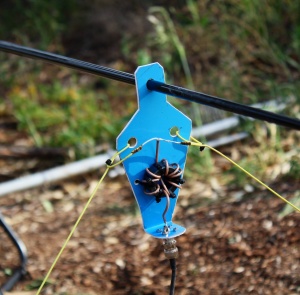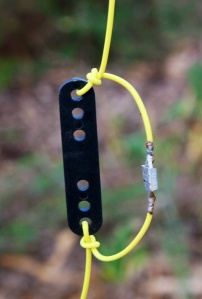Here is my take on the Linked Dipole antenna which has proven popular for SOTA work…
For some upcoming activations, I needed to put together a linked 20-30-40 M dipole as an alternative antenna to the EFHW I had built for my first activation on Mt Lofty.
While thes antennas work well, I felt that those using a linked dipole were putting out a slightly better signal, hence my interest…
Thes linked dipole antennas are available to buy if that’s your thing but I much prefer to make my own…I have been hoarding stuff in my “Junk Box” for years so I had just about everything I needed, except the centre support. For this, I decided to cut one out of some scrap plastic I had kept. This plastic is thin, about 2mm thick but quite stiff, although it has a nice flex if put under stress. I came from a promotional “point of sale” tray that fitted under a printer from my work place. I have dozens of the bloody things! It proved easy to cut with a good pair of sharp scissors, and was easily shaped with my leatherman tool knife blade. Conveniently, it had a nice lip bent over past 90 degrees, perfect for mounting the BNC connector…
Although perhaps not really necessary at QRP levels, I decided to fit a choke balun at the feed point to keep any rf from flowing on the outside of the coax. I used a Jaycar CAT. No. L-1238 Toroid as I had some on hand, and wound about 8 turns of some excess RG-316 and soldered one end to the BNC connector while the other ends of the coax were crimped to each dipole wire…
For the dipole links I used automotive spade lugs, as I had some on hand…other ideas would be power pole type connectors or even bullet style connectors, whatever you think is a fair thing! I crimp mine, and use Aluminox paste in the joint to provide longevity. The insulators are actually from the packaging holding my youngest lads last Nerf Gun firmly to the cardboard! I live by the motto, “never throw anything out!” – here it came in handy…
- Dipole Link, I used automotive spade lugs and the insulators are left over bits of plastic from Xmas toy packaging!
I have mounted a bit of PVC pipe in the front yard so that I can slip my 9M Squid pole over it and quickly raise it for operating or testing out a new antenna. I used this to gear effect today, and starting on 20m, I was able to trim the dipole lengths and add the next sections in a relatively short time. I was also very fussy with the tuning, and trimmed each band to 1:1.2 or better. This lets the FT-817 develop full power into the antenna on each band – important when operating at 5watts QRP, every milliwatt counts!
I got to try out the linked Dipole during my latest Sota activation, and it seemed to worked well on the 3 bands it was designed for. Due to the very strong winds I was only able to get around 70 degrees of angle between each leg, where as I like 100 degrees or better as I believe there is some cancellation of the TX signal below this angle…
Success!
So there you have it, much more satifying than buying a ready made unit, cheaper as well, I think I’ll probably end up keeping the EFHW in the kit as its only one piece of wire, and I bet that it would be relatively straight forward to make a linked version of one of those as well.
Thats the beauty of this hobbly, you can experiment at will and build stuff to your heart’s content, or if your time poor then there are usually plenty of companies the affer what you want and are very willing to take your money!
See you on a summit!






Hi Andy, great to see you are back on the air. Good write up on the link dipole, I enjoyed reading the post. Congratulations on achieving Slothdom with the Shack Sloth award.
73
Andrew, VK1NAM
Cheers Andrew!
Pingback: My portable antenna/s | vk5pas
Does tying the wire to the insulator effect the antenna. On one hand it seems much simpler and easier and on the other it seems like one is adding a little coil or two at each connector. I have seen it done both ways and would love to just tie the wires if it does not hurt performance. Any comments or insight is greatly appreciated
Tom
W1TWS
Hi Tom,
Just tying it on as I have done here doesn’t seem to affect the performance of the antenna in any way that seems obvious. It works very well, has served me for a number of years with many contacts. There could be an issue if the antenna was cut for higher frequencies but I doubt a single turn like the knots used here are going to affect things. Another method you might like to try could be to pass the loop through the insulator and secure it with a cable tie. Either way will work. Just tying a knot is cheap, simple and quick though.